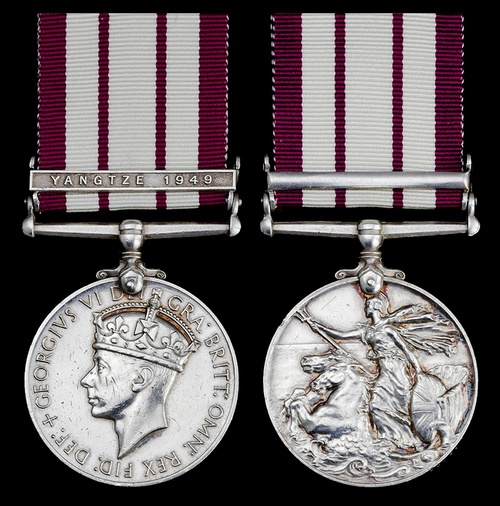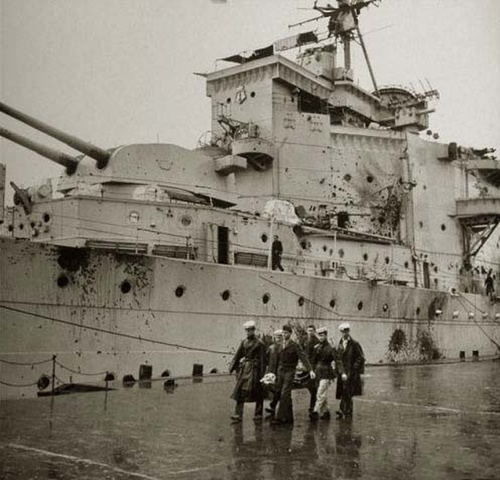Auction: 18001 - Orders, Decorations and Medals
Lot: 246
(x) 'These guns were well camouflaged and impossible to spot and it was they who caused most of our casualties. The last battery ceased fire at 1340. We had been under heavy fire for a total of 48 minutes, spread over a period of three hours. Our casualties were thirteen killed, fourteen seriously wounded and about 45 lightly wounded. Two of the seriously wounded unhappily died later.'
Commander R. F. Leonard, D.S.O., R.N., referring to losses aboard H.M.S. London
The rare Naval General Service Medal awarded to Able Seaman C. H. Brewis, Royal Navy, who was wounded aboard H.M.S. London during the Yangtze incident
Naval General Service 1915-62, 1 clasp, Yangtze 1949 (C/JX. 278986 C. H. Brewis, A.B., R.N.), light edge bruises, contact marks, very fine
Of London's gallant part in the 'Yangtze Incident', Commander R. F. Leonard, D.S.O., R.N., has written an extensive account - see http://www.hmslondon.org.uk/the%20commission.htm - from which the following extract has been taken:
'At 1000 on the 20th April 1949, heavy fire was opened on the Amethyst by the Communists in the vicinity of Rose Island. She was immediately and repeatedly hit on the Bridge and in the Wheelhouse, became out of control and still under heavy fire, grounded on Rose Island. London, wearing the Flag of Vice Admiral Madden, Second in Command, Far East Fleet, received Amethyst's report at 1100. She was then approaching the Yangtze Entrance Lightship on passage to Shanghai. Lower Deck was cleared, and the situation was explained to the Ship's Company. Then began the work of preparing the ship for possible action. There was much to be done. The lovely London was looking her best that morning. Her awnings were spread, her brightwork was shining, her illumination circuits were partly rigged ready for celebrations on St. George's Day. To strip her for action was a big task, both mental and physical.
We steamed on to Woosung, embarked two Chinese Pilots and Mr. Sudbury, a Whangpoo Pilot who also knew the Yangtze well, and continued up the Yangtze to Kiang Yen where we anchored for the night at 1900. Events had moved during the afternoon, Consort had steamed at full speed from Nanking to Amethyst's assistance. She too had been heavily fired on, and suffered damage and casualties. She was forced to abandon her attempts to tow Amethyst off and came down to Kiang Yin. She, and Black Swan, who had come down from Shanghai secured alongside us. Both ships were fuelled and our Medical Staff spent a busy night attending to Consort's wounded.
At 0615 on the 21st April we weighed, steamed 10 miles up the river and anchored again. Black Swan came with us, Consort returned to Shanghai. During the night, Amethyst had managed to get herself off and was now at anchor above Rose Island. All attempts to get in touch with Communist Headquarters had failed. At 1000 the Admiral decided to go up in London and attempt to bring the Amethyst down. Black Swan was to come as far as Beaver lsland and give covering fire if necessary.
Let us be clear on this point. To steam a 10,000-ton Cruiser past determined and well trained shore batteries in confined waters without prolonged and heavy preliminary bombardment is not a sound operation of war. But we were not at war with the Communists; the strength and efficiency of the batteries were not known and there was a good chance that the Communists would have realised their mistake in firing on British warships on the previous day, and would not fire at all. All the chances had been carefully weighed and we were prepared to give as good as we got if the opposition was determined.
At 1026 with the Ship's Company at Action Stations, we weighed and proceeded up the river at 25 knots. Large Union Jacks had been rigged on the front and sides of the Bridge and on the sides of the Hangars. They flew also from four Yardarms on the foremast and two on the Mainmast. This galaxy of bunting was completed by a large white flag at the Foremast head and an ensign at the peak. There could be no doubt in the mind of any man familiar with the British National Flag or the usage of the White Flag as to the Ship's Nationality or Peaceful Intentions.
At 1036, ten minutes after we had weighed, fire was opened from the North Bank. We were hit immediately by projectiles of 75 mm and 105 mm calibre. The firing continued for four minutes in spite of heavy and accurate counter-fire from the eight inch, four inch and close range weapons. After passing this battery, there was a lull till 1104 when it started again. Casualties and damage were becoming severe, particularly on the bridges, hangars and four inch Gun Decks. At 1106 a burst on the Bridge wounded the Captain and Officer of the Watch, mortally wounded the Navigating Officer and killed the Chinese Pilot. Damage to instruments and communications on the bridge were severe. We were now 19 miles from Amethyst's position, the bridge was temporarily out of action and the navigation of the river at high speed from the after conning position and without a Chinese Pilot was clearly impracticable.
It was clear that, in the doubtful event of our reaching Amethyst, the return trip escorting her at slow speed was foredoomed to failure. The time for withdrawal had come and the wheel was put hard-a-starboard. By great good fortune we were between two batteries, neither of which could bear on us while we turned. At 1114 we were safely round and regaining the centre of the Channel and, shortly after this, the bridge was able to take over from the After Conning Position again. Five more actions took place during the passage down the river. Each time the pattern was the same - a burst of fire from the Bank, quickly followed by our return fire. It was not a pleasant action to be in: the range was never more than 1,500 yards and hits were frequent and inevitable. The opposition consisted of 4 in. gun batteries well dug in, but plainly visible on the bank, and of anti-tank weapons of 40 mm calibre which fired high velocity armour piercing shot, which were capable of damaging 8 in. Gunhouse Armour and piercing Turret Trunking. These guns were well camouflaged and impossible to spot and it was they who caused most of our casualties. The last battery ceased fire at 1340. We had been under heavy fire for a total of 48 minutes, spread over a period of three hours. Our casualties were thirteen killed, fourteen seriously wounded and about 45 lightly wounded. Two of the seriously wounded unhappily died later.
It is difficult to assess the damage and casualties inflicted on the opposition, but at least eight direct hits with 8 in. H. E. Shell were obtained on the 4 in. batteries at an average range of 1,500 yards. In addition, 4 in. air bursts and close range direct fire must have caused many casualties in the target area. The Communists themselves admitted two hundred and fifty killed. Altogether we fired 155 rounds of 8 in., 449 rounds of 4 in. and 2,625 rounds of Close Range Ammunition.
Space does not permit the telling of the many stories of good and gallant work by parties and individuals of all departments and in every part of the ship. Nowhere did we find a weak link. The matter is best summed up by the following excerpt from the Captain's Official Report:
"All damage to the ship was quickly and efficiently dealt with by the Damage Control Parties, whose performance I consider to be outstanding, taking into consideration the difficulty of providing realistic training in these duties.
The bearing and conduct of the Ship's Company, a large proportion of whom are very young and were experiencing action for the first time, was beyond praise. As an instance, the 4 in. Gun Crews and Supply Parties suffered 38% casualties, who were instantly replaced as they fell. These guns continued in action throughout and fired a total of 449 rounds."
We secured at Holt's Wharf, Shanghai, that evening. Of the next few days of unremitting work patching the damage and clearing up the debris of battle, some memories stand out. The funeral of the dead from London, Consort and Amethyst at the Hung Jau Cemetery: Shanghai Cathedral packed to the doors for the Memorial Service on the following day: perhaps, above all, we will remember the overwhelming kindness and help of the American Navy in placing their hospital ship Repose at our disposal and assisting us in every possible way.
We had only four months to remain on the Station before going home. Our happy anticipation during that time was clouded by the thought of the Amethyst, still in her perilous and comfortless position in the grip of the Communists. When the news of Amethyst's brilliant and gallant escape came through on the 31st July, it brought a greater thrill to none than us. Now we could go home completely happy - the Yangtze Incident was finally and satisfactorily closed.'
Subject to 5% tax on Hammer Price in addition to 20% VAT on Buyer’s Premium. For more information please view Terms and Conditions for Buyers.
Sold for
£1,400







